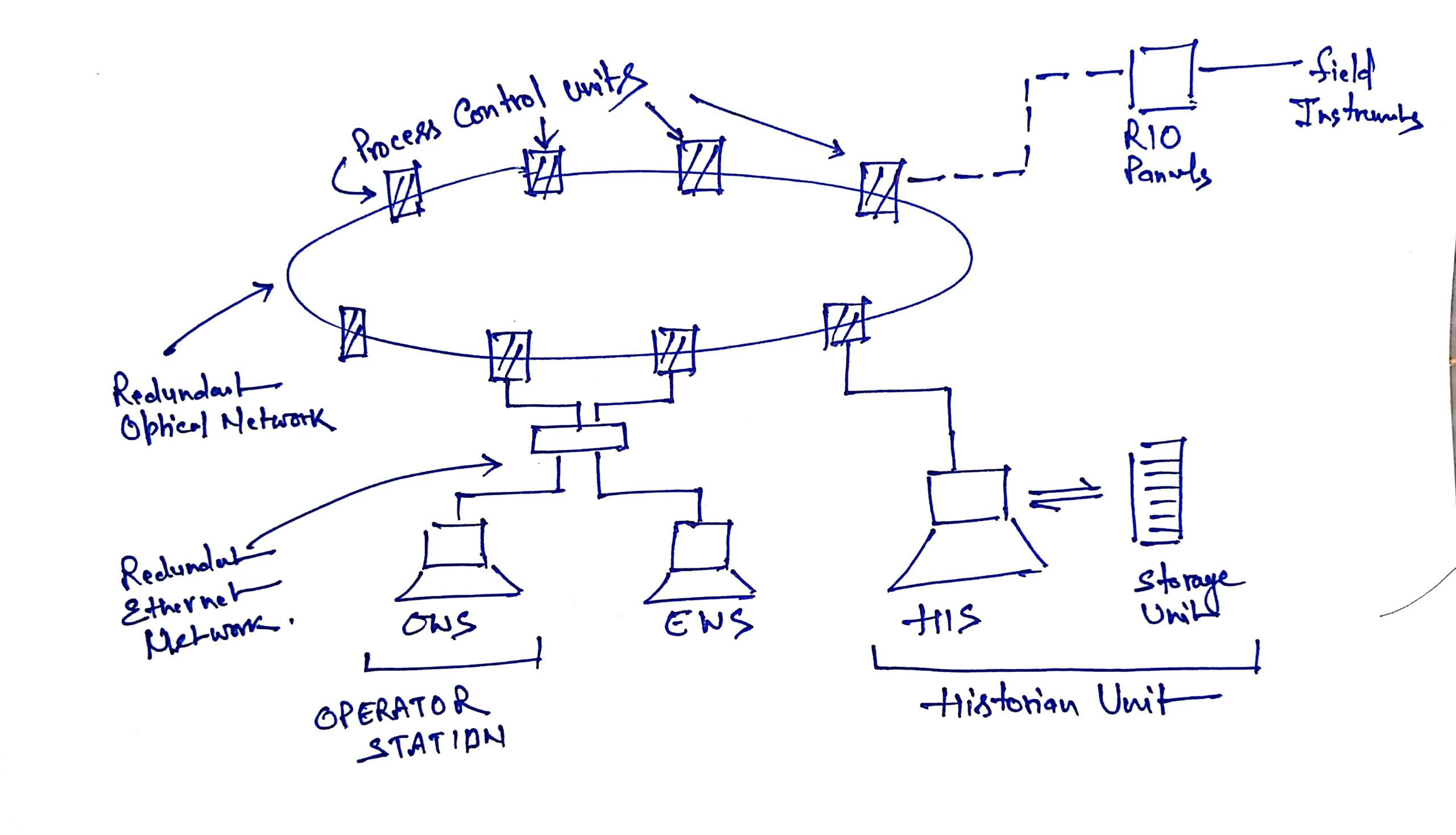In the ever-evolving landscape of industrial automation and control systems, the distributed control system (DCS) plays a pivotal role in ensuring seamless operations, efficiency, and safety across various industries. In this comprehensive guide, we delve into the intricacies of the DCS block diagram, shedding light on its components, functions, and significance in modern industrial processes.

Table of Contents
ToggleIntroduction of Distributed Control System Block Diagram
A Distributed Control System (DCS) is a sophisticated framework that orchestrates the control and monitoring of complex industrial processes. It is widely employed in sectors ranging from manufacturing, energy, and chemical processing to ensure the smooth and reliable functioning of critical operations. To fully comprehend the essence of a DCS, it is imperative to dissect its block diagram and decipher the functionalities it encapsulates.
Distributed Control System Block Diagram Component
Distributed control system block diagram is made with many different blocks which are used for different functionality of process automation in any industry.

Process Control Units / Controllers in Distributed Control System Block Diagram
At the core of any Distributed Control System block diagram lies the Process Control Units (PCUs). These units are responsible for acquiring data from sensors and transmitters located throughout the industrial plant. They collect vital information about variables such as temperature, pressure, flow rate, and level. This data forms the foundation for real-time decision-making within the system.
Controllers, another crucial element, interpret the data received from the PCUs and execute control actions based on predefined algorithms and setpoints. These algorithms are designed to optimize the industrial process, ensuring it operates within the desired parameters. Common types of controllers include Proportional-Integral-Derivative (PID) controllers and programmable logic controllers (PLCs).
Operator Workstations in Distributed Control System Block Diagram
Operator workstations in Distributed Control System block diagram, often referred to as operator consoles or control stations, are specialized computer setups used in various industries and applications to enable human operators to monitor, control, and interact with complex systems or processes. These workstations play a critical role in industries such as manufacturing, energy, transportation, telecommunications, and more. Here’s a description of operator workstations and their key characteristics:
- Data Visualization
- Real-time Monitoring
- Control Capabilities
- Alarm and Alert Systems
- Remote Access
Engineering Workstations in Distributed Control System Block Diagram
Engineering workstations, in the Distributed Control System block diagram, often simply referred to as “workstations,” are specialized computer systems designed for engineers and professionals for logic development. These high-performance computers are tailored to meet the demands of engineering, scientific, and design tasks.
SCADA / HMI
SCADA (Supervisory Control and Data Acquisition) and HMI (Human-Machine Interface) are two integral components of industrial automation and control systems. They play critical roles in monitoring and controlling industrial processes and systems. Here’s a description of SCADA and HMI systems and their key characteristics:
SCADA (Supervisory Control and Data Acquisition)
System Supervision:
SCADA systems are designed for supervising and controlling complex industrial processes, such as manufacturing, power generation, water treatment, and oil and gas production.
Data Acquisition:
SCADA systems collect data from various sensors and instruments distributed throughout a facility or system. This data includes parameters like temperature, pressure, flow rate, and more.
Real-time Monitoring:
SCADA systems provide real-time monitoring capabilities, allowing operators to view the current status of processes and equipment on graphical displays. This data is crucial for making informed decisions and identifying anomalies or issues.
Data Logging:
SCADA systems log historical data, enabling operators and engineers to analyze trends, track changes over time, and identify potential problems.
Remote Control:
SCADA systems often offer remote control functionality, enabling operators to adjust parameters, initiate or stop processes, and respond to alarms from a central control location.
Alarms and Alerts:
SCADA systems generate alarms and alerts when specific conditions or thresholds are met or exceeded. These notifications can be visual, audible, or sent to designated personnel via email or text messages.
HMI (Human-Machine Interface):
User Interface:
HMI systems provide the user interface through which operators interact with SCADA systems and control industrial processes. This interface typically consists of a graphical display, touchscreen, keyboard, and sometimes physical buttons.
Visualization:
HMI systems use graphical elements like charts, graphs, and icons to represent process data and equipment status. This visual representation simplifies complex information for operators to understand quickly.
Data Presentation:
HMI systems present data in a user-friendly and intuitive manner, allowing operators to monitor multiple processes and parameters simultaneously. They can customize the display to suit their needs.
Control Functions:
Operators can use HMI screens to control equipment and processes, such as starting or stopping machinery, adjusting setpoints, and changing operating modes.
Trend Analysis:
HMI systems often include tools for trend analysis, enabling operators and engineers to review historical data and identify patterns or deviations.
Alarm Management:
HMI systems display alarms and alerts generated by the SCADA system, allowing operators to respond promptly to issues and take corrective actions.
Application / Historian Servers in Distributed Control System Block Diagram
In Distributed Control System Block Diagram an application server is a specialized software framework or platform that provides a runtime environment for hosting and executing SCADA and process control applications. Apart from application server, a Historian Server, in the context of industrial automation and data management, is a specialized software and hardware component used to collect, store, retrieve, and analyze historical data in trend format from various industrial processes and systems. Historian Servers play a crucial role in industries like manufacturing, energy, utilities, and transportation, where historical data analysis is essential for optimizing operations, troubleshooting issues, and ensuring regulatory compliance. Here’s a description of Historian Servers and their key characteristics:
Data Collection:
In Distributed Control System Block Diagram, Historian Servers are designed to collect data from various sources within an industrial environment. This data can include sensor readings, equipment performance metrics, process variables, and other relevant information.
Time-Series Data:
One of the primary features of Historian Servers is their ability to store time-series data, which means data points are associated with specific timestamps. This allows for accurate tracking of changes over time and the ability to perform historical trend analysis.
Data Compression:
To efficiently store large volumes of data, Historian Servers often employ data compression techniques. This reduces storage requirements while preserving the essential details of the data.
Historical Trend Analysis:
Historian Servers support the creation of historical trends and charts, enabling engineers and operators to identify patterns, anomalies, and correlations in the data. This is valuable for predictive maintenance and process optimization.
Security and Data Integrity:
Security features are crucial in Historian Servers to protect sensitive industrial data. They often include user authentication, access controls, data encryption, and audit trails to maintain data integrity and compliance.
Integration:
Historian Servers can integrate with various industrial automation systems, including SCADA (Supervisory Control and Data Acquisition) systems, PLCs (Programmable Logic Controllers), and HMI (Human-Machine Interface) systems to capture data from diverse sources.
Historical Reporting:
These servers often come with tools or APIs for generating historical reports, which can be essential for compliance reporting, performance analysis, and decision-making.
Data Archiving:
In some cases, Historian Servers also facilitate data archiving, allowing organizations to offload older historical data to long-term storage while retaining easy access to recent and relevant data.
Popular Historian Server solutions in the industry include OSIsoft PI System, Wonderware Historian, GE Digital Historian, and Honeywell Uniformance PHD, among others. These systems provide the infrastructure and tools necessary for organizations to effectively capture, manage, and leverage historical data for operational excellence and informed decision-making in industrial processes.
Communication Network
A robust communication network serves as the backbone of a Distributed Control System Block Diagram. It facilitates seamless data exchange between various components of the system, ensuring that information flows swiftly and accurately. Ethernet, Profibus, and Modbus are some of the common communication protocols used in DCS setups.
On the other hand Redundancy is a critical feature in DCS to ensure uninterrupted operation. Redundant controllers, communication networks, and power supplies minimize the risk of system failure. In the event of a failure in one part of the system, the redundant component takes over seamlessly, averting potential disasters.
Watch our video for Distributed Control System Block Diagram
Conclusion
In conclusion, Distributed Control System Block Diagram is the backbone of industrial process automation and the DCS block diagram is the blueprint of industrial process automation. It outlines the key components – from the DCS itself to the Operator Workstation, Communication Network, Process Controllers, and Input/Output Modules. Understanding this diagram is essential for industries seeking precision, real-time monitoring, fault tolerance, and data-driven decision-making in their operations. By delving into the intricacies of the Distributed Control System Block Diagram, industries can unlock the potential for enhanced efficiency and competitiveness in the modern industrial landscape.
Q: What is a Distributed Control System (DCS)?
A: A Distributed Control System (DCS) is a specialized control system used in industrial processes and manufacturing to manage and control various components and processes across a distributed network of controllers and field devices.
Q: What is the primary purpose of a DCS in industrial applications? Explain in Distributed Control System Block Diagram.
A: The primary purpose of a DCS is to monitor and control industrial processes, ensuring they run efficiently, safely, and in compliance with operational requirements and safety standards.
Q: How does a DCS differ from other control systems, such as PLCs and SCADA? Explain in Distributed Control System Block Diagram.
A: DCS systems are designed for larger, complex processes and emphasize distributed control and real-time data sharing across the system. PLCs (Programmable Logic Controllers) are more suitable for discrete control, while SCADA (Supervisory Control and Data Acquisition) systems focus on data acquisition and visualization.
Q: What are some typical components of a DCS?
A: Components of a DCS may include controllers, I/O (Input/Output) modules, operator workstations, field devices (sensors and actuators), communication networks, and engineering stations for system configuration.
Q: How does data communication work within a DCS? Explain Distributed Control System Block Diagram.
A: DCS systems use communication networks to transmit data between controllers, field devices, and operator workstations. Common communication protocols include Ethernet, Profibus, and Foundation Fieldbus.
Q: What are the advantages of using a DCS in industrial processes?
A: DCS systems offer advantages such as centralized control, real-time monitoring, fault tolerance, scalability, and the ability to optimize processes, resulting in improved efficiency and safety.
Q: Can a DCS be used in batch processes and continuous processes?
A: Yes, DCS systems are versatile and can be employed in both batch and continuous processes. They provide the flexibility to adapt to various industrial operations.
Q: How are DCS systems configured and customized for specific industrial processes? Explain in Distributed Control System Block Diagram.
A: DCS systems are configured and customized through engineering workstations, where control strategies, graphics, and alarms are defined to match the requirements of the specific process.
Q: Are DCS systems suitable for critical industries like nuclear power plants and petrochemical refineries?
A: Yes, DCS systems are widely used in critical industries due to their reliability, redundancy features, and safety functionalities, making them suitable for applications where safety and precision are paramount.
Q: What is the role of redundancy in DCS systems, and why is it important? Explain in Distributed Control System Block Diagram.
A: Redundancy in DCS systems involves duplicating critical components to ensure system availability and fault tolerance. It is vital to prevent system failures that could lead to costly downtime or safety risks.
Q: Can DCS systems be integrated with other industrial automation systems and enterprise-level software?
A: Yes, DCS systems are designed to integrate with various industrial automation components, including PLCs, SCADA systems, and enterprise resource planning (ERP) software, to provide a comprehensive solution for process control and management.
Q: How do DCS systems contribute to safety in industrial processes?
A: DCS systems enhance safety through features like emergency shutdowns, alarms, interlocks, and the ability to implement safety instrumented systems (SIS) to mitigate risks and protect personnel and equipment.
Q: What trends are emerging in the field of DCS technology?
A: Emerging trends in DCS technology include increased connectivity through the Industrial Internet of Things (IIoT), cloud-based solutions, advanced analytics, and cybersecurity measures to protect against cyber threats.
